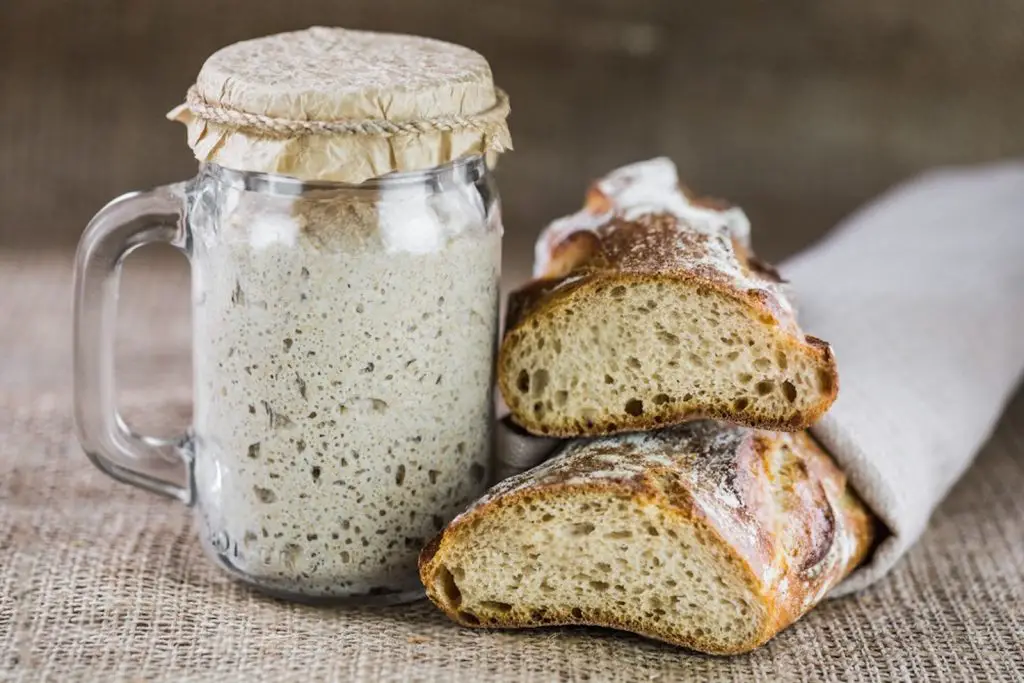
Potato salad, a classic and comforting dish, is a delightful medley of tender potatoes combined with a creamy and tangy dressing, often enriched with mayonnaise, mustard, and various herbs and spices. This beloved side dish holds a special place at picnics, barbecues, and family gatherings, providing a refreshing and satisfying accompaniment to a wide array of meals. Whether adorned with crunchy vegetables, hard-boiled eggs, or bacon, potato salad offers a delightful burst of flavors and textures that make it a crowd-pleaser. However, preparing a large batch of potato salad can lead to leftovers, raising the question of how to best preserve its deliciousness. Freezing potato salad becomes a practical solution to extend its enjoyment, allowing you to savor the delectable taste and creamy goodness of this cherished dish whenever the occasion calls for a delightful side, without the need for a fresh preparation. In this guide, we will explore the best practices for freezing potato salad, ensuring that its creamy texture, flavorful dressing, and delightful combination of ingredients remain lovingly preserved, ready to elevate your meals with a taste of homemade comfort, even when you wish to enjoy this beloved side dish at your convenience.
Here are the simple steps to freeze potato salad:
Step 1: Prepare the Fresh Potato Salad
When freezing potato salad, the first crucial step is to ensure that the salad is fresh and properly prepared. The quality of the potato salad before freezing will significantly impact its taste and texture when thawed and served later.
To begin, make sure that all the ingredients used in the potato salad are fresh and of good quality. Start with high-quality potatoes that are firm and free from any signs of spoilage. If you plan to add other vegetables or ingredients, such as celery, onions, pickles, or hard-boiled eggs, ensure they are fresh as well.
Once you have gathered all the necessary ingredients, mix them thoroughly to distribute the flavors evenly. This step ensures that every spoonful of the potato salad offers a balanced combination of ingredients and enhances the overall taste experience.
After mixing the ingredients, it’s essential to chill the potato salad in the refrigerator before freezing. Chilling the salad allows the flavors to meld together and sets the ingredients in place, preventing them from separating during the freezing process. Moreover, refrigeration helps to inhibit bacterial growth and maintain the freshness of the salad.
The refrigeration step is particularly crucial if you’ve just prepared the potato salad at room temperature. Allowing it to cool in the refrigerator for at least an hour before freezing will lower its temperature, reducing the risk of temperature shock in the freezer.
By ensuring that your potato salad is fresh, well-mixed, and adequately chilled, you set the foundation for preserving its delightful taste and texture during freezing. The flavors will be locked in, and when you thaw and serve the salad in the future, it will still carry the delicious essence you intended when preparing it. Remember, proper preparation is key to enjoying a scrumptious potato salad even after it’s been frozen.
Step 2: Portion the Potato Salad
After ensuring that your potato salad is fresh and well-prepared, the next important step is to divide it into smaller portions before freezing. Freezing the potato salad in large quantities can lead to several issues that may compromise its quality when thawed later.
The primary reason for dividing the potato salad into smaller portions is to promote even freezing and thawing. When you freeze a large quantity of potato salad in one container, the center of the mass takes longer to freeze completely. This uneven freezing can result in ice crystals forming within the salad, leading to a loss of texture and potentially affecting the taste.
On the other hand, dividing the salad into smaller portions reduces the overall mass of each container. This allows the salad to freeze more quickly and evenly throughout. As a result, the texture and flavor of the potato salad are better preserved, giving you a more consistent and enjoyable experience when you decide to thaw and serve it.
Moreover, freezing smaller portions allows for more flexibility in using the salad later. If you freeze the entire batch together, you would need to thaw and consume the entire quantity at once, which might not always be practical. By dividing the salad, you can thaw only the amount you need, reducing the risk of wastage.
Additionally, freezing in smaller portions makes it easier to handle and store the potato salad in the freezer. You can stack the smaller containers neatly, maximizing space utilization and organization within your freezer.
To portion the potato salad, use a ladle or large spoon to transfer it into individual airtight containers. Rigid plastic containers or heavy-duty freezer bags work well for this purpose. Be sure to leave some space at the top of each container to allow for slight expansion during freezing.
Dividing the potato salad into smaller portions before freezing is a practical step to ensure even freezing, better preservation of texture and flavor, and reduced waste. It’s a simple yet crucial measure that will enhance your frozen potato salad experience and make it more convenient to enjoy this delicious dish whenever you desire.
Step 3: Use Suitable Freezer Containers
Selecting the right containers for freezing potato salad is vital to maintaining its quality and preventing any potential contamination. The choice of containers plays a significant role in preserving the taste, texture, and overall freshness of the salad during its time in the freezer.
When freezing potato salad, it’s essential to opt for containers that are specifically designed for freezer use. Rigid airtight containers and heavy-duty freezer bags are among the most suitable options. These containers are made from materials that are resistant to low temperatures, preventing the salad from absorbing unwanted odors and flavors from the surrounding environment.
Rigid airtight containers are ideal because they provide a solid barrier against air and moisture, preventing freezer burn and ice crystals from forming within the potato salad. These containers seal tightly, reducing the risk of exposure to freezer air and ensuring the salad remains in optimal condition.
On the other hand, heavy-duty freezer bags are an excellent alternative, especially for those with limited freezer space. These bags are designed to be puncture-resistant, minimizing the risk of leaks or spills in the freezer. They are also convenient for storing irregularly shaped portions of potato salad, as they can be sealed tightly around the contents, minimizing excess air.
Before using any container for freezing, ensure that it is clean and free from any contaminants. Washing the containers with warm, soapy water and thoroughly rinsing them will remove any residue or lingering odors that could potentially affect the taste of the salad.
Once you have chosen the suitable containers and prepared them, carefully fill them with the portioned potato salad. Leave some space at the top of each container to allow for slight expansion during freezing. Press down gently to remove any trapped air pockets before sealing to further minimize the risk of freezer burn.
Properly sealed containers will also prevent the potato salad from absorbing odors and flavors from other foods in the freezer. This ensures that the salad retains its authentic taste and doesn’t develop any unwanted off-flavors during storage.
By using suitable freezer containers, you can ensure that your potato salad remains fresh, flavorful, and free from contamination while stored in the freezer. This step is essential in preserving the quality of the salad so that when you decide to thaw and serve it, you can savor the same delicious taste and texture as when it was first prepared.
Step 4: Fill the Containers Correctly
When freezing potato salad, filling the containers correctly is a crucial step to ensure the salad retains its quality and to prevent potential issues during the freezing process. Properly filling the containers allows for the necessary expansion that occurs as the salad freezes, avoiding spillage and maintaining the integrity of the dish.
As potato salad freezes, water molecules within the salad turn into ice crystals, causing the volume of the salad to expand slightly. If the container is filled to the brim, there won’t be enough room for this expansion, leading to pressure buildup within the container. This pressure can cause the lid to pop off, or in some cases, the container might crack, resulting in a messy and wasteful situation in the freezer.
To avoid such mishaps, it’s essential to leave some space at the top of each container when filling it with potato salad. A general rule of thumb is to leave about half an inch to one inch of space between the top of the salad and the lid of the container.
This space allows for the salad to expand as it freezes, without putting excess pressure on the container. It also helps in preventing the salad from coming into contact with the lid, which could cause freezer burn or affect the texture of the exposed parts of the salad.
When filling the containers, use a spoon or spatula to gently press down on the salad. This helps to remove any trapped air pockets, ensuring a more compact and uniform filling. Be careful not to press too hard, as this may crush the salad and alter its texture.
If using a rigid airtight container, ensure that the lid is sealed tightly to create a proper barrier against air and moisture. For heavy-duty freezer bags, squeeze out any excess air before sealing to minimize the risk of freezer burn.
By filling the containers with potato salad correctly and leaving enough room for expansion, you can avoid potential accidents, maintain the salad’s integrity, and ensure it remains in perfect condition during its time in the freezer. This step contributes to the overall success of freezing potato salad, allowing you to enjoy the delicious taste and texture of the salad when you decide to thaw and serve it.
Step 5: Seal and Label the Containers
Sealing and labeling the containers properly is a crucial step in freezing potato salad to maintain its quality and ensure you can easily manage its storage and consumption.
Sealing the Containers:
When freezing potato salad, it’s essential to seal the containers tightly to prevent air from entering. Exposure to air can lead to freezer burn, which can affect the texture and flavor of the salad. Freezer burn occurs when moisture on the surface of the salad evaporates and recondenses into ice crystals, causing the salad to become dehydrated and lose its freshness.
To avoid freezer burn, ensure that the lids of rigid airtight containers or the seals of heavy-duty freezer bags are secured tightly. Check that there are no gaps or openings that would allow air to enter. Press down on the lids or seals to ensure a snug fit and to expel any excess air from the container.
Labeling the Containers:
Properly labeling each container is essential for keeping track of the storage time and contents of the frozen potato salad. Use a waterproof marker or labels to write the date of freezing on each container. This will help you know how long the salad has been in the freezer and enable you to prioritize consuming the oldest portions first.
Organizing the Freezer:
When placing the labeled and sealed containers in the freezer, try to arrange them neatly. Stacking containers in a single layer initially allows for faster freezing and easier access. Once the salad is fully frozen, you can stack containers on top of each other to save space and keep the freezer organized.
By properly sealing and labeling the containers, you can safeguard your frozen potato salad from the effects of air exposure and ensure you consume it within its optimal timeframe. Following these steps will help you enjoy the same delightful taste and texture of the potato salad when you decide to thaw and serve it later on.
Step 6: Store in the Freezer
Once you have sealed and labeled the containers with the potato salad, it’s time to store them in the freezer. Proper storage in the freezer is crucial to maintain the salad’s quality and ensure it remains safe for consumption during its frozen storage period.
Placement in a Single Layer:
When initially storing the sealed containers in the freezer, try to position them in a single layer. Placing the containers side by side allows for better air circulation around each container, promoting faster and more even freezing. It also helps prevent the containers from sticking together, making it easier to retrieve individual portions later on.
Keeping the containers in a single layer during the initial freezing stage also reduces the risk of pressure build-up within the containers. As the potato salad freezes, it may expand slightly, and having enough space around each container prevents any undue stress on the container lids or seals.
Stacking After Freezing Solid:
Once the potato salad is frozen solid, which typically takes several hours or overnight, you can stack the containers to save space in the freezer. Stacking the containers allows you to make the most efficient use of the available freezer space, especially if you have limited room.
When stacking, try to place the containers of frozen potato salad carefully on top of each other to prevent any crushing or damage to the salads. If you have different portion sizes, consider stacking the smaller containers on top of larger ones to create a stable arrangement.
Using stackable containers or freezer bags with flat bases can aid in maintaining stability when stacking. Be mindful of the weight distribution and avoid stacking too high to prevent any potential accidents when reaching for a specific container.
Organizing the Freezer:
Maintaining an organized freezer is beneficial when freezing multiple batches of potato salad or other frozen items. Group similar items together and label them accordingly to make it easier to locate specific containers later on.
Consider creating a designated area in the freezer for your frozen potato salad to keep it separate from other frozen foods and prevent cross-contamination of flavors and odors.
Regularly check the freezer’s temperature to ensure it remains at or below 0 degrees Fahrenheit (-18 degrees Celsius) to ensure proper freezing and preservation of the potato salad.
By storing the sealed containers of potato salad in the freezer properly, you can maintain its quality, prevent freezer burn, and keep it safe for consumption throughout its storage period. Following these storage guidelines will help you enjoy the same delicious taste and texture of the potato salad when you decide to thaw and serve it in the future.
How long can potato salad last in the freezer?
Potato salad can last in the freezer for up to 3 months. Beyond this period, its quality may start to deteriorate, and it may be more prone to freezer burn. It is recommended to consume frozen potato salad within the 3-month timeframe for optimal taste and texture.
Step 7: Thaw the Frozen Salad
Thawing frozen potato salad properly is essential to preserve its taste, texture, and overall quality. Improper thawing can lead to uneven defrosting and potentially compromise the salad’s flavors. Following the correct thawing method ensures that the potato salad remains safe to eat and maintains its deliciousness.
Thawing in the Refrigerator:
The recommended method for thawing frozen potato salad is to transfer the sealed container from the freezer to the refrigerator and allow it to thaw slowly. Thawing in the refrigerator provides a controlled environment where the temperature is cool enough to prevent bacterial growth but not so low that it compromises the texture of the salad.
Plan ahead and remove the container of frozen potato salad from the freezer the night before you intend to serve it. Place it on a plate or in a container to catch any potential drips as it thaws.
Thawing overnight allows for gradual defrosting, which ensures the salad’s texture and flavors are retained. The cool temperature of the refrigerator prevents the growth of harmful bacteria that could occur at warmer temperatures during thawing.
Avoid Using a Microwave:
It’s essential to avoid using a microwave to thaw potato salad. Microwaving can lead to uneven defrosting, with some parts becoming overly warm while others remain frozen. Additionally, the microwave’s heat can cause the mayonnaise in the salad to separate, resulting in a less appealing texture.
Microwaving may also lead to the development of hot spots within the salad, which can potentially harbor harmful bacteria if not heated evenly.
Thawing in Cold Water (Alternative):
If you need to thaw the potato salad more quickly than the refrigerator method allows, you can use the cold water thawing method. Place the sealed container of frozen potato salad in a larger container of cold water. Change the water every 30 minutes to ensure it remains cold.
This method accelerates thawing while maintaining a safe temperature range to prevent bacterial growth. However, it’s crucial to avoid using warm or hot water, as it can lead to the development of harmful bacteria and compromise the salad’s safety.
By following the proper thawing method, you can enjoy the frozen potato salad with the same delightful taste and texture as when it was freshly prepared. Thawing in the refrigerator ensures that the salad remains safe to eat and maintains its quality, providing a delicious and safe side dish for your meal.
Other related questions
Can you refreeze potato salad?
It is generally not recommended to refreeze potato salad once it has been thawed. Refreezing can lead to a loss of quality, as the texture and taste may be compromised. Additionally, the risk of bacterial growth increases when food is repeatedly thawed and refrozen. It is best to consume thawed potato salad promptly or discard any leftovers to ensure food safety and optimal enjoyment.
How do I know if the potato salad has gone bad after being frozen?
To determine if frozen potato salad has gone bad, check for signs of spoilage. Look for any unusual odors, off-color appearance, or changes in texture, such as excessive mushiness or separation of ingredients. If the potato salad exhibits any of these signs, it is best to discard it to avoid the risk of foodborne illness. When in doubt, trust your senses and err on the side of caution to ensure food safety.
Should I freeze potato salad before or after adding dressing?
It is generally recommended to freeze potato salad before adding the dressing. Freezing with the dressing can result in changes to the texture and consistency of the ingredients, particularly with mayo-based dressings. By freezing the salad without the dressing, you can add it fresh after thawing to maintain the best taste and texture.
Can you freeze potato salad with Greek yogurt instead of mayo?
Yes, you can freeze potato salad with Greek yogurt as a substitute for mayo. Greek yogurt tends to freeze better than mayo, helping to maintain the salad’s texture after thawing. However, it’s essential to be aware that the taste and consistency may slightly differ from the original version due to freezing, so it’s advisable to test a small batch first before freezing a large quantity.
Can you freeze homemade potato salad with sour cream?
Yes, you can freeze homemade potato salad with sour cream, but it may undergo some changes in texture and flavor after thawing. Sour cream has a higher water content, which can lead to separation and a slightly watery consistency upon thawing. To minimize these effects, ensure the potato salad is well chilled before freezing and mix it thoroughly after thawing to help restore its original texture.
Can you freeze potato salad with red potatoes?
Yes, you can freeze potato salad made with red potatoes. Red potatoes have a waxy texture, which helps them retain their shape and texture better during freezing and thawing compared to russet potatoes. To preserve the quality, make sure the salad is properly cooled before freezing and stored in airtight containers. Upon thawing, the red potato salad should maintain its taste and texture relatively well.








